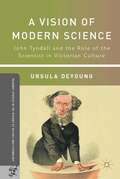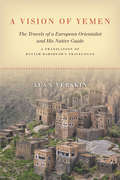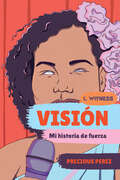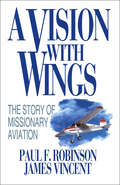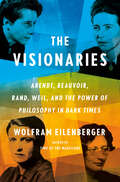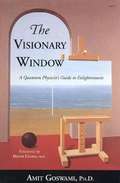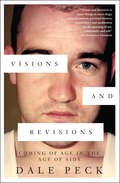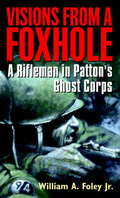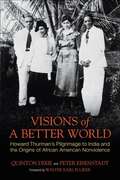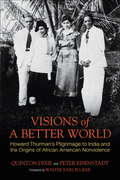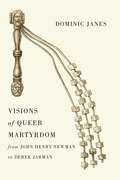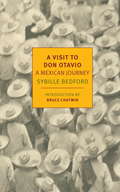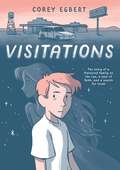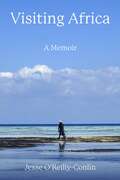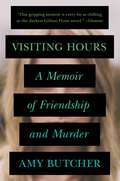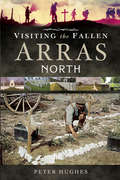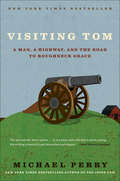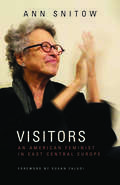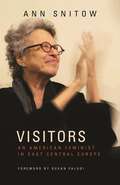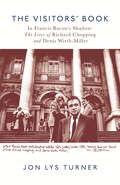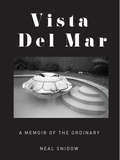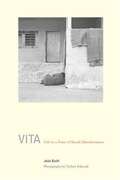- Table View
- List View
A Vision of Modern Science: John Tyndall and the Role of the Scientist in Victorian Culture (Palgrave Studies in the History of Science and Technology)
by Ursula DeyoungAn examination of a pivotal moment in the history of science through the career and cultural impact of the historically neglected Victorian physicist John Tyndall,establishing him as an important figure of the period, whose scientific discoveries and philosophy of science in society are still relevant today.
A Vision of Yemen: The Travels of a European Orientalist and His Native Guide, A Translation of Hayyim Habshush's Travelogue
by Alan VerskinIn 1869, Hayyim Habshush, a Yemeni Jew, accompanied the European orientalist Joseph Halévy on his archaeological tour of Yemen. Twenty years later, Habshush wrote A Vision of Yemen, a memoir of their travels, that provides a vivid account of daily life, religion, and politics. More than a simple travelogue, it is a work of trickster-tales, thick anthropological descriptions, and reflections on Jewish–Muslim relations. At its heart lies the fractious and intimate relationship between the Yemeni coppersmith and the "enlightened" European scholar and the collision between the cultures each represents. The book thus offers a powerful indigenous response to European Orientalism. This edition is the first English translation of Habshush's writings from the original Judeo-Arabic and Hebrew and includes an accessible historical introduction to the work. The translation maintains Habshush's gripping style and rich portrayal of the diverse communities and cultures of Yemen, offering a potent mixture of artful storytelling and cultural criticism, suffused with humor and empathy. Habshush writes about the daily lives of men and women, rich and poor, Jewish and Muslim, during a turbulent period of war and both Ottoman and European imperialist encroachment. With this translation, Alan Verskin recovers the lost voice of a man passionately committed to his land and people.
Visión (Vision Spanish Language Edition): Mi historia de fuerza
by Precious PerezIn this Spanish-language edition of Vision, a young blind activist shares how she became a leader for the disabled community. Ever since Precious Perez was a child, she has loved to sing. Her family always praised her singing, saying she could even attend Berklee College of Music one day—planting a seed that would become her dream. Precious was born two-and-a-half months premature and weighed just one pound. Her eyes did not develop fully, and she is blind. Growing up, most people focused on what Precious could not do because of her disability. With her teacher’s support, Precious realized all the things she could do with her disability—starting with attending Berklee. This Spanish-language edition of Precious’s compelling first-person narrative brings forward an empowering first-person account of a woman finding strength and purpose in her disability to a wider audience. “[A] triumphant story of a young person’s success.”—School Library Journal “Readers will be engaged by [Perez’s] honesty, tenaciousness, and belief.”—Booklist
A Vision with Wings: The Story of Missionary Aviation
by Paul F. Robinson James VincentTake off with the pioneers in missionary aviation and learn about the vision and impact of fifty years of flying around the world. Learn how Nate Saint helped usher in modern mission flying as he brought the gospel to the Auca tribe of Ecuador. Meet Betty Greene, the first pilot for Mission Aviation Fellowship. Follow the dream of Paul Robinson, the pastor-pilot who founded Moody Aviation, the aviation program that trains one-half of the world's missionary pilots.
A Vision with Wings: The Story of Missionary Aviation
by Paul F. Robinson James VincentTake off with the pioneers in missionary aviation and learn about the vision and impact of fifty years of flying around the world. Learn how Nate Saint helped usher in modern mission flying as he brought the gospel to the Auca tribe of Ecuador. Meet Betty Greene, the first pilot for Mission Aviation Fellowship. Follow the dream of Paul Robinson, the pastor-pilot who founded Moody Aviation, the aviation program that trains one-half of the world's missionary pilots.
The Visionaries: Arendt, Beauvoir, Rand, Weil, and the Power of Philosophy in Dark Times
by Wolfram EilenbergerA soaring intellectual narrative starring the radical, brilliant, and provocative philosophers Simone de Beauvoir, Hannah Arendt, Simone Weil, and Ayn Rand by the critically acclaimed author of Time of the Magicians, Wolfram EilenbergerThe period from 1933 to 1943 was one of the darkest and most chaotic in human history, as the Second World War unfolded with unthinkable cruelty. It was also a crucial decade in the dramatic, intersecting lives of some of history&’s greatest philosophers. There were four women, in particular, whose parallel ideas would come to dominate the twentieth century—at once in necessary dialogue and in striking contrast with one another.Simone de Beauvoir, already in a deep emotional and intellectual partnership with Jean-Paul Sartre, was laying the foundations for nothing less than the future of feminism. Born Alisa Rosenbaum in Saint Petersburg, Ayn Rand immigrated to the United States in 1926 and was honing one of the most politically influential voices of the twentieth century. Her novels The Fountainhead and Atlas Shrugged would reach the hearts and minds of millions of Americans in the decades to come, becoming canonical libertarian texts that continue to echo today among Silicon Valley&’s tech elite. Hannah Arendt was developing some of today&’s most important liberal ideas, culminating with the publication of The Origins of Totalitarianism and her arrival as a peerless intellectual celebrity. Perhaps the greatest thinker of all was a classmate of Beauvoir&’s: Simone Weil, who turned away from fame to devote herself entirely to refugee aid and the resistance movement during the war. Ultimately, in 1943, she would starve to death in England, a martyr and true saint in the eyes of many.Few authors can synthesize gripping storytelling with sophisticated philosophy as Wolfram Eilenberger does. The Visionaries tells the story of four singular philosophers—indomitable women who were refugees and resistance fighters—each putting forward a vision of a truly free and open society at a time of authoritarianism and war.
The Visionary Window: A Quantum Physicist's Guide to Enlightenment
by Amit GoswamiA thrilling synthesis of science and mysticism by a quantum physicist reared in the Hindu tradition with a thorough knowledge of Indian sacred literature. Goswami offers solid, scientific explanations for the concept of universal consciousness and the existence of mind beyond the function of the brain. Thoughtful readers will love his ingenious mix of data and ideas from Eastern philosophy, transpersonal psychology, and quantum physics to explore the scientific principles for why and how spiritual practice works.
Visions and Revisions: Coming of Age in the Age of AIDs
by Dale PeckNovelist and critic Dale Peck's latest work--part memoir, part extended essay--is a foray into what the author calls "the second half of the first half of the AIDS epidemic," i.e., the period between 1987, when the AIDS Coalition to Unleash Power (ACT UP) was founded, and 1996, when the advent of combination therapy transformed AIDS from a virtual death sentence into a chronic manageable illness.Reminiscent of Joan Didion's The White Album and Kurt Vonnegut's Palm Sunday, Visions and Revisions is a sweeping, collage-style portrait of a tumultuous era. Moving seamlessly from the lyrical to the analytical to the reportorial, Peck's story takes readers from the serial killings of gay men in New York, London, and Milwaukee, through Peck's first loves upon coming out of the closet, to the transformation of LGBT people from marginal, idealistic fighters to their present place in a world of widespread, if fraught, mainstream acceptance.The narrative pays particular attention the words and deeds of AIDS activists, offering a streetlevel portrait of ACT UP with considerations of AIDS-centered fiction and criticism of the era, as well as intimate, sometimes elegiac portraits of artists, activists, and HIV-positive people Peck knew. Peck's fiery rhetoric against a government that sat on its hands for the first several years of the epidemic is tinged with the idealism of a young gay man discovering his political, artistic, and sexual identity. The result is a visionary and indispensable work from one of America's most brilliant and controversial authors.
Visions From a Foxhole
by William FoleyAn absolutely harrowing first-person account of the 94th Infantry Division's bold campaign to break through Hitler's "impregnable" Siegfried line at the end of World War IIEighteen-year-old William Foley was afraid the war would be over before he got there, but the rifleman was sent straight to the front lines, arriving January 25, 1945-just in time to join the 94th Infantry Division poised at Hitler's legendary West Wall. By the time Foley finally managed to grab a few hours sleep three nights later, he'd already fought in a bloody attack that left sixty percent of his battalion dead or wounded. That was just the beginning of one of the toughest, bloodiest challenges the 94th would ever face: breaking through the Siegfried Line. Now, in Visions from a Foxhole, Foley recaptures that desperate, nerve-shattering struggle in all its horror and heroism.Features the author's artwork of his fellow soldiers and battle scenes, literally sketched from the foxholeLook for these remarkable stories of American courage at warBEHIND HITLER'S LINESThe True Story of the Only Soldier to Fight for BothAmerica and the Soviet Union in World War IIThomas H. TaylorTHE HILL FIGHTSThe First Battle of Khe Sanhby Edward F. MurphyNO BENDED KNEEThe Battle for Guadalcanalby Gen. Merrill B. Twining, USMC (Ret.)THE ROAD TO BAGHDADBehind Enemy Lines: The Adventures of an American Soldier in the Gulf Warby Martin StantonFrom the Paperback edition.
Visions of a Better World
by Quinton H. Dixie Peter EisenstadtThe first biographical exploration of one of the most important African American religious thinkers of the twentieth century--Howard Thurman--and of the pivotal trip he took to India that ultimately shaped the course of the civil rights movement. In 1935, Howard Thurman took a trip to India that would forever change him. He became the first African American to meet with Mahatma Gandhi and found himself called to create a version of American Christianity that was intolerant of self-imposed racial and religious boundaries. Deeply influenced by Gandhi's philosophy and practice of satyagraha, his translation of the idea into a Black Christian context became one of the key tenets of the civil rights movement, influencing an entire generation of black ministers--most notably Martin Luther King, Jr. Visions of a Better Worldexplores this pivotal trip and its effect on the very shape of the civil rights tradition. Drawing from previously untapped archival material and obscurely published works, Quinton Dixie and Peter Eisenstadt outline, for the first time, Thurman's development into the towering theologian who would so profoundly influence the epochal shift in U. S. race relations in the mid-twentieth century.
Visions of a Better World
by Peter Eisenstadt Quinton DixieIn 1935, at the height of his powers, Howard Thurman, one of the most influential African American religious thinkers of the twentieth century, took a pivotal trip to India that would forever change him--and that would ultimately shape the course of the civil rights movement in the United States. When Thurman (1899-1981) became the first African American to meet with Mahatma Gandhi, he found himself called upon to create a new version of American Christianity, one that eschewed self-imposed racial and religious boundaries, and equipped itself to confront the enormous social injustices that plagued the United States during this period. Gandhi's philosophy and practice of satyagraha, or "soul force," would have a momentous impact on Thurman, showing him the effectiveness of nonviolent resistance. After the journey to India, Thurman's distinctly American translation of satyagraha into a Black Christian context became one of the key inspirations for the civil rights movement, fulfilling Gandhi's prescient words that "it may be through the Negroes that the unadulterated message of nonviolence will be delivered to the world." Thurman went on to found one of the first explicitly interracial congregations in the United States and to deeply influence an entire generation of black ministers--among them Martin Luther King Jr. Visions of a Better World depicts a visionary leader at a transformative moment in his life. Drawing from previously untapped archival material and obscurely published works, Quinton Dixie and Peter Eisenstadt explore, for the first time, Thurman's development into a towering theologian who would profoundly affect American Christianity--and American history.
Visions of Queer Martyrdom from John Henry Newman to Derek Jarman
by Dominic JanesWith all the heated debates around religion and homosexuality today, it might be hard to see the two as anything but antagonistic. But in this book, Dominic Janes reveals the opposite: Catholic forms of Christianity, he explains, played a key role in the evolution of the culture and visual expression of homosexuality and male same-sex desire in the nineteenth and twentieth centuries. He explores this relationship through the idea of queer martyrdom closeted queer servitude to Christ a concept that allowed a certain degree of latitude for the development of same-sex desire. Janes finds the beginnings of queer martyrdom in the nineteenth-century Church of England and the controversies over Cardinal John Henry Newman s sexuality. He then considers how liturgical expression of queer desire in the Victorian Eucharist provided inspiration for artists looking to communicate their own feelings of sexual deviance. After looking at Victorian monasteries as queer families, he analyzes how the Biblical story of David and Jonathan could be used to create forms of same-sex partnerships. Finally, he delves into how artists and writers employed ecclesiastical material culture to further queer self-expression, concluding with studies of Oscar Wilde and Derek Jarman that illustrate both the limitations and ongoing significance of Christianity as an inspiration for expressions of homoerotic desire. Providing historical context to help us reevaluate the current furor over homosexuality in the Church, this fascinating book brings to light the myriad ways that modern churches and openly gay men and women can learn from the wealth of each other s cultural and spiritual experience. "
A Visit to Don Otavio: A Mexican Journey
by Bruce Chatwin Sybille BedfordIn the mid-1940s, Sybille Bedford set off from Grand Central Station for Mexico, accompanied by her friend E., a hamper of food and drink (Virginia ham, cherries, watercress, a flute of bread, Portuguese rosé), books, a writing board, and paper. Her resulting travelogue captures the violent beauty of the country she visited. Bedford doesn't so much describe Mexico as take the reader there--in second-class motor buses over thousands of miles, through arid noons and frigid nights, successions of comida corrida, botched excursions to the coast, conversations recorded verbatim, hilarious observations, and fascinating digressions into murky histories. At the heart of the book is the Don Otavio of the title, the travelers' gracious host, his garrulous family and friends, and his Edenic hacienda at Lake Chapala. Published in 1953, A Visit to Don Otavio was an immediate success, "a travel book written by a novelist," as Bedford described it, establishing her reputation as a nonpareil writer.
Visitations
by Corey EgbertInspired by true events, this haunting yet hopeful young adult graphic novel weaves together family dynamics, mental illness, and religion—perfect for fans of Hey, Kiddo.Corey’s mom has always made him feel safe. Especially after his parents’ divorce, and the dreaded visitations with his dad begin. But as Corey grows older, he can’t ignore his mother’s increasingly wild accusations. Her insistence that God has appointed Corey as his sister’s protector. Her declaration that Corey’s father is the devil.Soon, she whisks Corey and his sister away from their home and into the boiling Nevada desert. There, they struggle to survive with little food and the police on the trail. Meanwhile, under the night sky, Corey is visited by a flickering ghost, a girl who urges him to fight for a different world—one outside of his mother’s spoon-fed tales, one Corey must find before it’s too late.Drawing inspiration from his own upbringing in the Mormon church, Corey Egbert welcomes readers on an emotionally stirring, nuanced journey into the liminal spaces between imagination and memory, faith and truth.
Visiting Africa: A Memoir
by Jesse O'Reilly-ConlinVisiting Africa: A Memoir is a personal journey as well as a physical one: it is about my ongoing and evolving attempt to approach Africa and its cultures with humility and modesty and about my struggles as a privileged white man to ethically encounter and live in a world marked by injustice and racialized inequality. It takes up the present challenge of resurrecting stories that challenge dominant narratives. It is an investigation of privilege and how the privileged must overcome their own defensiveness and feelings of guilt if they are to stand in solidarity with those people they meet and write about. Finally, this book is an investigation into the possibilities of empathy.
Visiting Hours
by Amy ButcherIn this powerful and unforgettable memoir, award-winning writer Amy Butcher examines the shattering consequences of failing a friend when she felt he needed one most. Four weeks before their college graduation, twenty-one-year-old Kevin Schaeffer walked Amy Butcher to her home in their college town of Gettysburg, Pennsylvania. Hours after parting ways with Amy, he fatally stabbed his ex-girlfriend, Emily Silverstein. While he was awaiting trial, psychiatrists concluded that he had suffered an acute psychotic break. Although severely affected by Kevin's crime, Amy remained devoted to him as a friend, believing that his actions were the direct result of his untreated illness. Over time, she became obsessed--determined to discover the narrative that explained what Kevin had done. The tragedy deeply shook her concept of reality, disrupted her sense of right and wrong, and dismantled every conceivable notion she'd established about herself and her relation to the world. Eventually realizing that she would never have the answers, or find personal peace, unless she went after it herself, Amy returned to Gettysburg--the first time in three years since graduation--to sift through hundreds of pages of public records: mental health evaluations, detectives' notes, inventories of evidence, search warrants, testimonies, and even Kevin's own confession.Visiting Hours is Amy Butcher's deeply personal, heart-wrenching exploration of how trauma affects memory and the way a friendship changes and often strengthens through seemingly insurmountable challenges. Ultimately, it's a testament to the bonds we share with others and the profound resilience and strength of the human spirit.
Visiting Life: Women Doing Time on the Outside
by Bridget KinsellaWhen a friend who taught creative writing at a maximum-security prison asked Bridget Kinsella to read the work of one of his best students, she readily agreed. As a publishing professional, Kinsella was used to getting manuscripts from all sorts of sources. Who knows? she told herself. Maybe I can help this talented inmate get his work published. She had no idea that her correspondence with a convicted murderer serving life without parole would lead to a relationship that would change her life forever. Why in the world would anyone get involved with a prison inmate? In this beautifully written, brutally honest memoir, Kinsella shares how she stumbled into a relationship with a lifer and became part of a sorority she never thought she'd join. Over the course of three years, she spends time with and ultimately befriends the wives, girlfriends, and mothers of some inmates at Pelican Bay. On this unexpected journey, she learns of the hurdles, heartbreaks, and hopes they have for their relationships as she experiences a connection with someone who helps heal her own wounds. As the United States continues to incarcerate convicted criminals for increasingly long periods of time, our prison rolls swell to unprecedented levels--more than two million today--as does the number of women and children whose lives are thrown into limbo and who live for their next "visiting time. " Through the lens of her own unlikely experience, Kinsella examines those impacted by crime and punishment with keen observation, candor, and compassion. From the Hardcover edition.
Visiting the Fallen: Arras: North
by Peter HughesLike Ypres, Arras was a front line town throughout the Great War. From March 1916 it became home to the British Army and it remained so until the Advance to Victory was well under way. In 1917 the Battle of Arras came and went. It occupied barely half a season, but was then largely forgotten; the periods before and after it have been virtually ignored, and yet the Arras sector was always important and holding it was never easy or without incident; death, of course, was never far away. The area around Arras is as rich in Commonwealth War Graves Commission cemeteries as anywhere else on the Western Front, including the Somme and Ypres, and yet these quiet redoubts with their headstones proudly on parade still remain largely unvisited. This book is the story of the men who fell and who are now buried in those cemeteries; and the telling of their story is the telling of what it was like to be a soldier on the Western Front. 'Arras-North' is the first of three books by the same author. This volume contains in depth coverage of almost sixty Commonwealth War Graves Commission cemeteries and is a veritable 'Who's Who' of officers and other ranks who fell on this part of the Western Front. It provides comprehensive details of gallantry awards and citations and describes many minor operations, raids and other actions, as well as the events that took place in April and May 1917. It is the story of warfare on the Western Front as illustrated through the lives of those who fought and died on the battlefields of Arras.There are many unsung heroes and personal tragedies, including a young man who went out into no man's land to rescue his brother, an uncle and nephew killed by the same shell, a suicide in the trenches and a young soldier killed by a random shell whilst celebrating his birthday with his comrades. There is an unexpected connection to Ulster dating back to the days of Oliver Cromwell and William of Orange, a link to Sinn Fein and an assassination, a descendant of Sir Isaac Newton, as well as a conjuror, a friend of P.G. Wodehouse, a young officer said to have been 'thrilled' to lead his platoon into the trenches for the first time, only to be killed three hours later, and a man whose headstone still awaits the addition of his Military Medal after almost a century, despite having been involved in one of the most daring rescues of the war. This is a superb reference guide for anyone visiting Arras and its battlefields.
Visiting Tom: A Man, a Highway, and the Road to Roughneck Grace
by Michael PerryTom is 82-year-old Tom Hartwig, an old-timer best known locally for building and firing homemade cannons. Toiling in a shop that Perry describes as an "antique store stocked by Rube Goldberg, curated by Hunter Thompson, and rearranged by a small earthquake," Tom works from scratch to make everything from shovel handles to parts for quarter-million-dollar farm equipment. He has an endless reservoir of stories dating back to the days of his prize Model A. Visiting Tom is dominated by the elderly man's equanimity and ultimately by unvarnished tenderness. Tuesdays with Morrie meets Shop Class as Soulcraft as Michael Perry, a middle-aged father of daughters, finds guidance and inspiration in visits with his octogenarian, cannon-shooting neighbor. Visiting Tom celebrates the wisdom, heart, and sass of a vanishing generation that embodies the indomitable spirit of small-town America.
The Visitor
by Liam Matthew BrockeyIn an age when few people ventured beyond their place of birth, André Palmeiro left Portugal on a journey to the far side of the world. Bearing the title âeoeFather Visitor,âe#157; he was entrusted with the daunting task of inspecting Jesuit missions spanning from Mozambique to Japan. A global history in the guise of a biography, The Visitor tells the story of a theologian whose extraordinary travels bore witness to the fruitful contactâe"and violent collisionâe"of East and West in the early modern era. In India, Palmeiro was thrust into a controversy over the missionary tactics of Roberto Nobili, who insisted on dressing the part of an indigenous ascetic. Palmeiro walked across Southern India to inspect Nobiliâe(tm)s mission, recording fascinating observations along the way. As the highest-ranking Jesuit in India, he also coordinated missions to the Mughal Emperors and the Ethiopian Christians, as well as the first European explorations of the East African interior and the highlands of Tibet. Orders from Rome sent Palmeiro farther afield in 1626, to Macau, where he oversaw Jesuit affairs in East Asia. He played a crucial role in creating missions in Vietnam and seized the opportunity to visit the Chinese mission, trekking thousands of miles to Beijing as one of Chinaâe(tm)s first Western tourists. When the Tokugawa Shogunate brutally cracked down on Christians in Japanâe"where neither he nor any Westerner had power to interveneâe"Palmeiro died from anxiety over the possibility that the last Jesuits still alive would apostatize under torture.
Visitors: An American Feminist in East Central Europe
by Ann SnitowA feminist organizer in East Central Europe after the fall of the Berlin Wall reveals the struggles of women fighting for their rights during the rise of the Right in EuropeVisitors tells the story of Ann Snitow’s adventures as a Western feminist helping to build a new, post-communist feminist movement in Eastern Central Europe. Snitow stumbles onto this fast-changing, chaotic scene by chance, but falls in love with the passionate feminists she meets in Poland, the former Czechoslovakia and Yugoslavia, Hungary and Romania. What kinds of feminism should they hope for?Visitors is a book about forging enduring relationships and creating formerly unimaginable institutions—a feminist school, the Network of East-West Women, women’s centers, gender studies programs. It is about unity amid fractiousness and perseverance through uncertainty, Snitow’s flickering lodestar. Visitors moves gracefully between vivid anecdote, political analysis, and unsparing introspection. It is richly peopled with “brilliant” comrades and vexing detractors alike, all described with respect and humor. Every sentence is imbued with the experience and insight of this sui generis feminist activist, writer, and pedagogue of 50 years. Most of all, Visitors is the story of friendship, the heart and sinew of the leaderless feminist movement. Reading like the best historical novel, it is intimate and worldly, resolutely unsentimental yet finally, even as the political skies darken, optimistic in the conviction that feminism can make life meaningful, fascinating, fun, pleasurable—and better for everyone, even as better is redefined again and again.
Visitors: An American Feminist in East Central Europe
by Ann SnitowA feminist organizer in East Central Europe after the fall of the Berlin Wall reveals the struggles of women fighting for their rights during the rise of the Right in EuropeVisitors tells the story of Ann Snitow’s adventures as a Western feminist helping to build a new, post-communist feminist movement in Eastern Central Europe. Snitow stumbles onto this fast-changing, chaotic scene by chance, but falls in love with the passionate feminists she meets in Poland, the former Czechoslovakia and Yugoslavia, Hungary and Romania. What kinds of feminism should they hope for?Visitors is a book about forging enduring relationships and creating formerly unimaginable institutions—a feminist school, the Network of East-West Women, women’s centers, gender studies programs. It is about unity amid fractiousness and perseverance through uncertainty, Snitow’s flickering lodestar. Visitors moves gracefully between vivid anecdote, political analysis, and unsparing introspection. It is richly peopled with “brilliant” comrades and vexing detractors alike, all described with respect and humor. Every sentence is imbued with the experience and insight of this sui generis feminist activist, writer, and pedagogue of 50 years. Most of all, Visitors is the story of friendship, the heart and sinew of the leaderless feminist movement. Reading like the best historical novel, it is intimate and worldly, resolutely unsentimental yet finally, even as the political skies darken, optimistic in the conviction that feminism can make life meaningful, fascinating, fun, pleasurable—and better for everyone, even as better is redefined again and again.
The Visitors' Book: In Francis Bacon's Shadow: The Lives of Richard Chopping and Denis Wirth-Miller
by Jon Lys TurnerDenis Wirth-Miller and Dicky Chopping were a couple at the heart of the mid-twentieth century art world, with the visitors' book of the Essex townhouse they shared from 1945 until 2008 painting them as Zeligs of British society. The names recorded inside make up an astonishing supporting cast - from Francis Bacon to Lucian Freud to Randolph Churchill to John Minton. Successful artists, although not household names themselves, writing Dicky and Denis off as just footnotes in history would be a mistake. After Denis's death in 2010, Jon Lys-Turner, one of two executors of the couple's estate, came into possession of an extraordinary archive of letters, works of art and symbolically loaded ephemera the two had collected since they met in the 1930s. It is no exaggeration to state that this archive represents a missing link in British art history - the wealth of new biographical information disclosed about Francis Bacon, for example, is truly staggering. The Visitors' Book is both an extraordinary insight into the minutiae of Dicky and Denis's life together and what it meant to be gay in pre-Wolfenden Britain, as well as a pocket social history of the era and a unique perspective into mid-twentieth century art. With reams of previously unseen material, this is a fascinating and unique opportunity to delve into post-war Britain.
Vista Del Mar: A Memoir of the Ordinary
by Neal SnidowThis remarkable book joins the company of "self-work," deep acts of memory that serve to illuminate the present by shining the clear light of careful regard on the past. The book finds company in the work of D J Waldie's Holy Land, Didion's Slouching Towards Bethlehem, and the profound My Struggle by Karl Ove Knausgaard.In 1996 Neal Snidow found himself at a personal impasse as he and his wife struggled in vain to have a child. Locked in sadness at their predicament, in mid-career as a college teacher and unpublished writer, and at the first daunting steps of open adoption, as a kind of solace Neal began taking black and white photos of his old neighborhood in southern California. The film was slow, the camera on a tripod, the process awkward, and the goal no more than Garry Winogrand's famous dictum that he made pictures "to find out what something will look like photographed."But as this process unfolded and the images began to accumulate, slowly but surely the pictures unlocked the past, and he began to delve into family history, opening out the secret and the unspoken and evoking the lost pleasures and losses of the beach town where he had grown up. The chapters that followed, like the photos that now accompanied them, were quietly observant of an ordinary surface around which gathered an aura of struggle, gaiety and loss. He titled the book Vista Del Mar, for the street that ran past his old apartment to the edge of the Pacific, and gave it the subtitle a memoir of the ordinary in testimony to the everydayness of the experiences he explored. The chapters move back and forth in time and place, to Virginia, to a homestead in Wyoming, to depression-era Nebraska, to the Second World War. Aunts, uncles, ancestors, beach denizens, characters of film noir, and finally a miraculous new baby, all populate the pages which despite the struggles they relate conclude on a major chord of reconciliation and hope.
Vita: Life in a Zone of Social Abandonment
by Torben Eskerod João BiehlZones of social abandonment are emerging everywhere in Brazil's big cities--places like Vita, where the unwanted, the mentally ill, the sick, and the homeless are left to die. This haunting, unforgettable story centers on a young woman named Catarina, increasingly paralyzed and said to be mad, living out her time at Vita. Anthropologist Joao Biehl leads a detective-like journey to know Catarina; to unravel the cryptic, poetic words that are part of the "dictionary" she is compiling; and to trace the complex network of family, medicine, state, and economy in which her abandonment and pathology took form. As Biehl painstakingly relates Catarina's words to a vanished world and elucidates her condition, we learn of subjectivities unmade and remade under economic pressures, pharmaceuticals as moral technologies, a public common sense that lets the unsound and unproductive die, and anthropology's unique power to work through these juxtaposed fields. "Vita's" methodological innovations, bold fieldwork, and rigorous social theory make it an essential reading for anyone who is grappling with how to understand the conditions of life, thought and ethics in the contemporary world.
